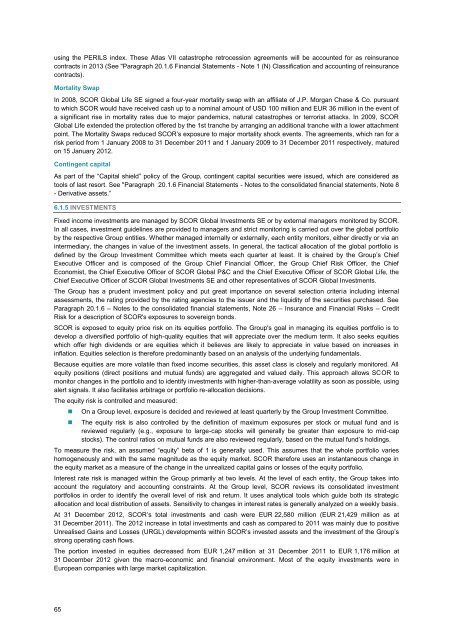4.4 Legal risk - Scor
4.4 Legal risk - Scor
4.4 Legal risk - Scor
You also want an ePaper? Increase the reach of your titles
YUMPU automatically turns print PDFs into web optimized ePapers that Google loves.
using the PERILS index. These Atlas VII catastrophe retrocession agreements will be accounted for as reinsurance<br />
contracts in 2013 (See "Paragraph 20.1.6 Financial Statements - Note 1 (N) Classification and accounting of reinsurance<br />
contracts).<br />
Mortality Swap<br />
In 2008, SCOR Global Life SE signed a four-year mortality swap with an affiliate of J.P. Morgan Chase & Co. pursuant<br />
to which SCOR would have received cash up to a nominal amount of USD 100 million and EUR 36 million in the event of<br />
a significant rise in mortality rates due to major pandemics, natural catastrophes or terrorist attacks. In 2009, SCOR<br />
Global Life extended the protection offered by the 1st tranche by arranging an additional tranche with a lower attachment<br />
point. The Mortality Swaps reduced SCOR’s exposure to major mortality shock events. The agreements, which ran for a<br />
<strong>risk</strong> period from 1 January 2008 to 31 December 2011 and 1 January 2009 to 31 December 2011 respectively, matured<br />
on 15 January 2012.<br />
Contingent capital<br />
As part of the “Capital shield” policy of the Group, contingent capital securities were issued, which are considered as<br />
tools of last resort. See "Paragraph 20.1.6 Financial Statements - Notes to the consolidated financial statements, Note 8<br />
- Derivative assets.”<br />
6.1.5 INVESTMENTS<br />
Fixed income investments are managed by SCOR Global Investments SE or by external managers monitored by SCOR.<br />
In all cases, investment guidelines are provided to managers and strict monitoring is carried out over the global portfolio<br />
by the respective Group entities. Whether managed internally or externally, each entity monitors, either directly or via an<br />
intermediary, the changes in value of the investment assets. In general, the tactical allocation of the global portfolio is<br />
defined by the Group Investment Committee which meets each quarter at least. It is chaired by the Group’s Chief<br />
Executive Officer and is composed of the Group Chief Financial Officer, the Group Chief Risk Officer, the Chief<br />
Economist, the Chief Executive Officer of SCOR Global P&C and the Chief Executive Officer of SCOR Global Life, the<br />
Chief Executive Officer of SCOR Global Investments SE and other representatives of SCOR Global Investments.<br />
The Group has a prudent investment policy and put great importance on several selection criteria including internal<br />
assessments, the rating provided by the rating agencies to the issuer and the liquidity of the securities purchased. See<br />
Paragraph 20.1.6 – Notes to the consolidated financial statements, Note 26 – Insurance and Financial Risks – Credit<br />
Risk for a description of SCOR's exposures to sovereign bonds.<br />
SCOR is exposed to equity price <strong>risk</strong> on its equities portfolio. The Group's goal in managing its equities portfolio is to<br />
develop a diversified portfolio of high-quality equities that will appreciate over the medium term. It also seeks equities<br />
which offer high dividends or are equities which it believes are likely to appreciate in value based on increases in<br />
inflation. Equities selection is therefore predominantly based on an analysis of the underlying fundamentals.<br />
Because equities are more volatile than fixed income securities, this asset class is closely and regularly monitored. All<br />
equity positions (direct positions and mutual funds) are aggregated and valued daily. This approach allows SCOR to<br />
monitor changes in the portfolio and to identify investments with higher-than-average volatility as soon as possible, using<br />
alert signals. It also facilitates arbitrage or portfolio re-allocation decisions.<br />
The equity <strong>risk</strong> is controlled and measured:<br />
• On a Group level, exposure is decided and reviewed at least quarterly by the Group Investment Committee.<br />
• The equity <strong>risk</strong> is also controlled by the definition of maximum exposures per stock or mutual fund and is<br />
reviewed regularly (e.g., exposure to large-cap stocks will generally be greater than exposure to mid-cap<br />
stocks). The control ratios on mutual funds are also reviewed regularly, based on the mutual fund’s holdings.<br />
To measure the <strong>risk</strong>, an assumed “equity” beta of 1 is generally used. This assumes that the whole portfolio varies<br />
homogeneously and with the same magnitude as the equity market. SCOR therefore uses an instantaneous change in<br />
the equity market as a measure of the change in the unrealized capital gains or losses of the equity portfolio.<br />
Interest rate <strong>risk</strong> is managed within the Group primarily at two levels. At the level of each entity, the Group takes into<br />
account the regulatory and accounting constraints. At the Group level, SCOR reviews its consolidated investment<br />
portfolios in order to identify the overall level of <strong>risk</strong> and return. It uses analytical tools which guide both its strategic<br />
allocation and local distribution of assets. Sensitivity to changes in interest rates is generally analyzed on a weekly basis.<br />
At 31 December 2012, SCOR’s total investments and cash were EUR 22,580 million (EUR 21,429 million as at<br />
31 December 2011). The 2012 increase in total investments and cash as compared to 2011 was mainly due to positive<br />
Unrealised Gains and Losses (URGL) developments within SCOR’s invested assets and the investment of the Group’s<br />
strong operating cash flows.<br />
The portion invested in equities decreased from EUR 1,247 million at 31 December 2011 to EUR 1,176 million at<br />
31 December 2012 given the macro-economic and financial environment. Most of the equity investments were in<br />
European companies with large market capitalization.<br />
65
















